Bosch Rexroth Corporation, Mobile Hydraulics
The final run-up to the complete implementation of TIER 4 regulations has begun. In 2014, diesel systems will be required to operate emitting only 10% of currently permitted levels of soot particulates and nitrous oxide (NOx). This significant reduction will force many mobile equipment manufacturers to fully redesign their systems. And those redesigns could impact the performance, flexibility, and reliability of the hydraulics that drive and control your mobile equipment's worktools.
To be in compliance and fully market-ready, postponing is not an option: crucial engineering and design decisions must be made now. If not, you may be forced to make complex, last-minute changes to mobile equipment design that will increase costs and impact your competitive value. If that happens, you also risk creating machines that are either underpowered or incorporate exhaust treatment systems that eat up valuable space and impact efficient system design.
The TIER 4 final challenge comes down to this: You can treat it as a regulatory roadblock that adds cost and complexity to your product development process, or you can treat it as an opportunity — to invest in cutting-edge technology that enables your systems to fully comply with TIER 4 final challenges, while delivering the power, performance, and flexibility your customers require for their complex mobile applications.
TIER 4 Final: 2014 Limits at a Glance
Bosch Rexroth has long invested in developing high-power hydraulic solutions to enable mobile machine builders to meet these challenges. Our suite of hydraulics and engineering concepts will unleash the potential of your machines, while ensuring you can deliver the emissions compliance, energy efficiency, and flexible performance the market demands.
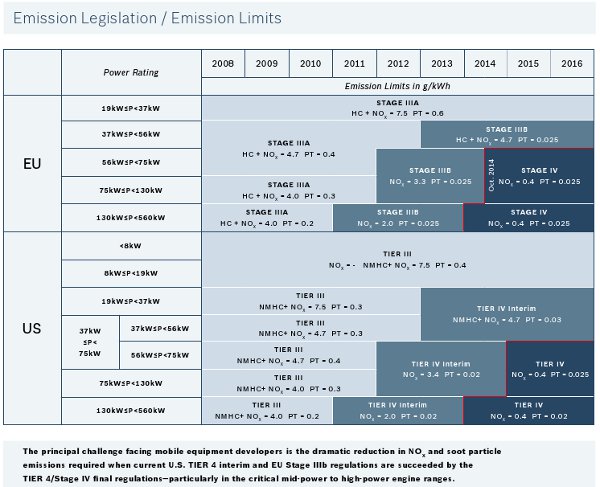
Key Technology Challenges
There are several highly interrelated technology challenges that will need to be addressed to meet TIER 4 final requirements
Comprehensive exhaust gas treatment: Starting in 2014, approximately 10% of the current soot and NOx emissions will be permitted. The combination of exhaust gas treatment and particle filters will have to be optimized. This will increase development outlay and costs, both for components regarding the exhaust gas treatment system and for additional post-treatment catalytic converters.
Expanded space requirements: Up until now, optimizing the performance of individual components has enabled many machines to remain in compliance; TIER 4's drastic emission reductions are expected to require wholesale redesign, and require exhaust cooling systems that may require 15 to 40% additional space on mobile machines — and for small to medium-size construction machinery, fitting it all in is a major engineering challenge.
Increased cooling requirements: Diesel engines will need to operate in a narrow optimum temperature band to maintain emissions compliance; this places new burdens on diesel cooling systems, lowering peak combustion temperatures while further reducing the particle content of exhaust gases.
Changed dynamic response of diesel engines: With TIER 4 final, hydraulic performance may potentially be impacted if designers choose to downsize diesel engine performance to achieve compliance. Downsizing the diesel engine can result in identical machine performance while reducing the installed drive power only by optimizing the hydraulic system performance.
Higher equipment and operating costs: While there is no question that the new exhaust cooling systems will require mobile equipment redesign, engineering and end-user costs can escalate if a piecemeal approach is taken to solving individual emissions and equipment redesign issues.
Rexroth TIER 4 Solutions: Integrated and Innovative
Bosch Rexroth, long a worldwide leader in industrial and mobile hydraulics technology, is ready to help you answer the challenges of TIER 4 final requirements. Our comprehensive approach to advancing hydraulics solutions combines innovative drive technology with intelligent electronics to help you achieve decisive competitive advantages as you work toward TIER 4 final compliance.
Rather than target one or two specific hydraulics products to the challenge of TIER 4 final compliance, Bosch Rexroth has developed a state-of-the-art suite of systems built on a holistic approach to optimizing energy efficiency and environmental compliance in mobile machines — what Bosch Rexroth calls BlueHydraulics:
Reduced emission — through intelligent networking and control of both diesel engines and hydraulics components that are ideally matched to operate and call on engine output in an optimal manner. Increased efficiency — through optimized individual components such as our A4VG variable pumps that increase overall efficiency, delivering power to hydraulics systems while demanding less power from diesel systems. Enhanced energy efficiency — hydraulics components such as Green Valves that provide added functionality while simultaneously making reduced energy consumption possible throughout the system.
Hydrostatic Fan Drives
Electronically controlled hydrostatic fan drives from Rexroth reliably keep combustion engines at their optimum operating temperature, even under the most difficult of application conditions. The system provides the precise amount of cooling output regardless of the speed of the combustion engine while reducing fuel consumption up to 5%. A sophisticated combination of axial piston pumps, external gear motors, polymer and steel tanks, valve technology, sensors and mobile electronics maintains engine temperature — critical to ensuring that TIER 4 final-compliant exhaust cooling systems also operate within strict limits to control emissions.
Demand-based control of the cooling output Stepless control of the fan speed regardless of the combustion engine speed Flexible arrangement of the components provides space savings Fan system with reverse and stop functions (optional)
Main applications: Buses, excavators, wheel loaders, mobile cranes, dump trucks, forestry machines
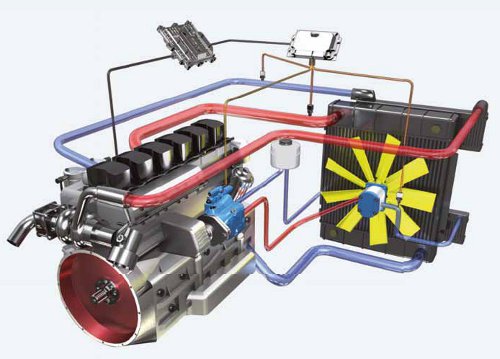
Downsizing for Compact Loaders
This engineering concept is based on highly efficient hydraulic systems that enable mobile equipment manufacturers to reduce diesel engine output without sacrificing the hydraulic performance of compact loaders.
By optimizing the performance of the travel drive, the working hydraulics, and the electronic control, it is possible to minimize emissions, fuel consumption, and space requirements using smaller engines — all without sacrificing the overall performance capability of the machine.
This approach lets mobile equipment builders keep their engines below the key 56 kW performance range where TIER 4 regulations become significant.
Downsizing the diesel engine from 68 kW to 55 kW Highly efficient hydraulics to maintain the same handling capacity of the machine 20% overall system efficiency increase Reduction of diesel engine speed while retaining full functionality
Main applications: Compact track loaders, skid steer loaders
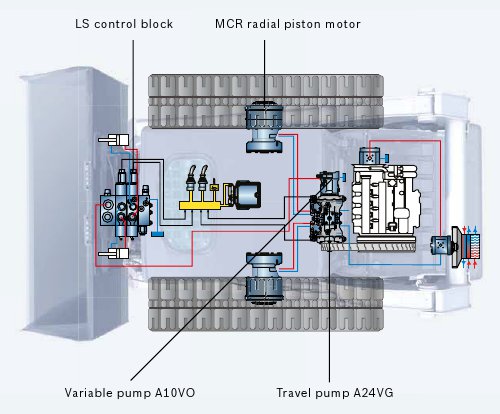
Diesel Hydraulic Control
Greater working dynamics at lower diesel engine speeds — this fundamental advance is achieved through the BODAS function module Diesel Hydraulic Control (DHC). This new control strategy, based on the intelligent networking and integration of both hydraulics and diesel engine control, maintains the accustomed high responsiveness of the travel and working hydraulics, even under worsened load assumption conditions and reduced engine speed.
Through a unique combination of Bosch know-how in diesel engine management with Rexroth's advanced expertise in hydraulic control, DHC provides a software-based solution that optimizes the cooperation between the two systems for the first time. The result: energy is only provided if and when it is really needed.
Up to 20% less fuel consumption Same machine dynamic response at lowered diesel engine speeds CAN communication (SAE J1939) between hydraulics and diesel engine controller No additional components required if the electrohydraulics are already present Ideal in combination with Bosch diesel engine controller
Main applications: Telehandlers, wheel loaders, backhoes, municipal vehicles, agricultural machinery
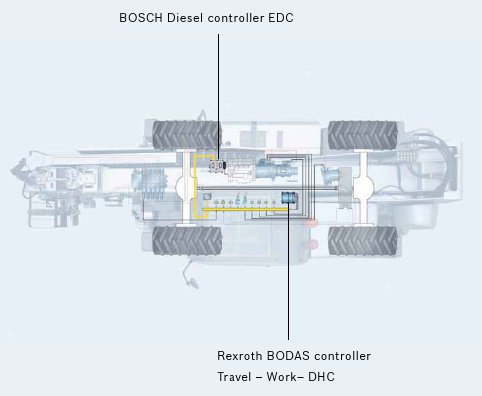
Energy-Efficient Excavator Controls
The greatest potential for energy efficiency is where the heaviest work is done, i.e. in excavators, where the single work motion utilizes the entire diesel engine output. Increasing energy efficiency through a more intelligent control of hydraulics means it is possible for mobile equipment users to avoid oversizing the diesel system they provide for excavators, which in turn makes TIER 4 final compliance easier and less complicated to achieve.
Combining Rexroth's EPC (Electronic Positive Control) and VBO (Virtual Bleed-Off) technologies enables the conversion of significantly more energy into efficient mechanical motion; this in turn offers the potential for double-digit energy savings by converting significantly more energy into mechanical work.
Electronic Positive Control (EPC)
Fast machine response characteristics High dynamic system stability Compatible with existing positive control systems Can be expanded to positive control with full EH valve control Fast machine response characteristics
Virtual Bleed-Off (VBO)
Good load sensitivity Soft, gentle control response High energy efficiency Expandable to VBO with full EH valve control
Main applications: Mobile excavators, crawler excavators
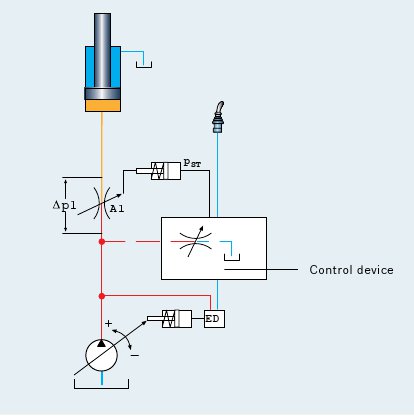
Hydraulic Fly Wheel
One key to TIER 4 final compliance is achieving more complete use of the energy created by the diesel engine, so it is not called upon to be larger, or operate more inefficiently, to deliver the power the hydraulic system needs to power mobile equipment worktools. Bosch Rexroth has been a pioneer in development and commercialization of hydraulic fly wheel systems, which capture unused and excess energy and efficiently make it available when needed.
Hydraulic fly wheels can be an effective and compact solution to enable diesel engine power smoothing, downsizing of the diesel engine, or as a boost functions.
Reduces fuel consumption and harmful emissions Optimizes operating point of diesel engine Protects against diesel over-rev Can provide a boost function for improved machine dynamics Effective for mobile machines with either frequent or infrequent travel cycles
Main applications: Excavators, compact wheel loaders, telehandlers, backhoes, rubber wheeled rollers
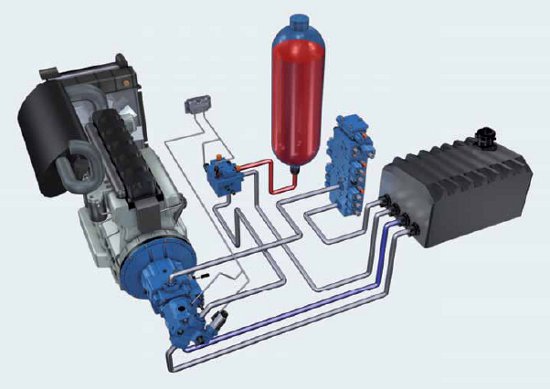
Solutions for TIER 4 Final: Expert Applications & Engineering Support
2014 is no longer a long way off. The reality is that manufacturers need to be finishing their system redesigns now so that there is sufficient time, after the prototype stage, to test TIER 4 final compliant systems and bring them to production readiness.
Rexroth can help: Our comprehensive suite of hydraulics technology has been designed to answer many of the performance and space challenges associated with TIER 4 final. With our application know-how, Rexroth can address your unique application-specific requirements with progressive hydraulic components already proven in the field.
Count on our expertise to optimize the performance of your mobile equipment hydraulics; this will free you to address other critical TIER 4 final-related issues in your mobile equipment, and help to reduce both the time and cost it will take for your operations to be ready for 2014.
Complete Range of Resources
The issues associated with achieving TIER 4 final continue to be complex; to help answer your questions and provide more complete support, Bosch Rexroth offers a comprehensive array of resources available online through our special TIER 4 final website at www.boschrexroth-us.com/tier4final.
Website: Get up-to-date details on TIER 4 final regulatory requirements, white papers from Rexroth hydraulics experts, and detailed descriptions of Rexroth hydraulics technology specifically engineered to enable TIER 4 final compliance.
Brochures: Download multiple brochures on Rexroth DHC, Hydrostatic Fan Drives, Energy Efficiency in Mobile Machines, BlueHydraulics, and other TIER 4 related products and solutions.
Webinars: Rexroth mobile technology experts address key TIER 4-related topics such as TIER 4 engines, exhaust system developments, and mobile equipment downsizing in these informative presentations.
Also link to Rexroth's website for Case Studies and Technical Articles describing how leading manufacturers used Rexroth products to solve performance, cost and application challenges.
© 2012 Bosch Rexroth Corporation





